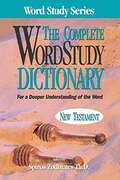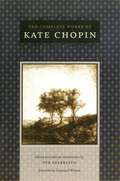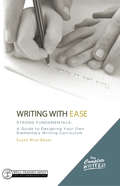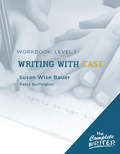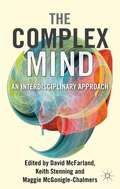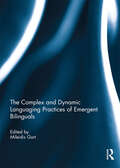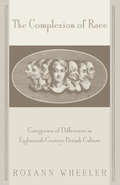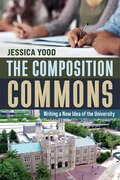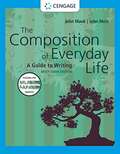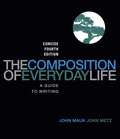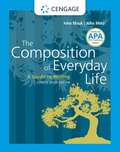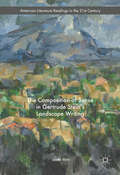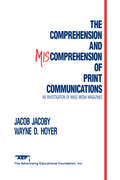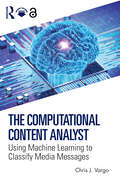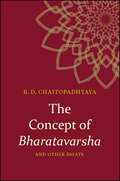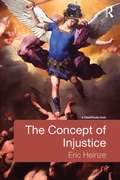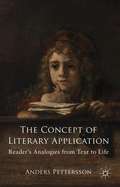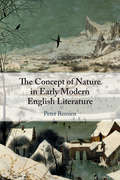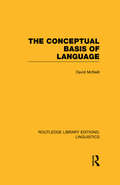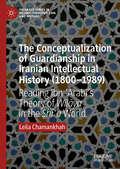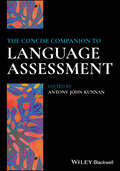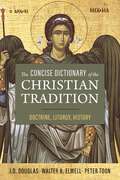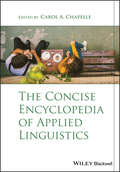- Table View
- List View
The Complete Word Study Dictionary New Testament (Word Study Ser.)
by Spiros ZodhiatesEvery word in the Greek New Testament is explained in great detail, covering all context usages for these words. Numbered to Strong's numbering system, each word has a basic definition and further commentary is provided by Dr. Spiros Zodhiates, noted Greek scholar. A companion Scripture Reference Index is provided for further
The Complete Works of Kalidasa, Volume 2
by Chandra RajanThe second volume contains the plays of Kalidasa. His knowledge of the human heart and his understanding of the complex play of human motivation are profound. A keen observer of nature in all its varied aspects, Kalidasa is at the same time a learned writer who wears his enormous learning lightly and with grace.
The Complete Works of Kate Chopin (Southern Literary Studies)
by Kate Chopin Per SeyerstedIn 1969, Per Seyersted gave the world the first collected works of Kate Chopin. Seyersted's presentation of Chopin's writings and biographical and bibliographical information led to the rediscovery and celebration of this turn-of-the-century author. Newsweek hailed the two-volume opus -- "In story after story and in all her novels, Kate Chopin's oracular feminism and prophetic psychology almost outweigh her estimable literary talents. Her revival is both interesting and timely." Now for the first time, Seyersted'sComplete Works is available in a single-volume paperback. It is the first and only paperback edition of Chopin's total oeuvre. Containing twenty poems, ninety-six stories, two novels, and thirteen essays -- in short, everything Chopin wrote except several additional poems and three unfinished children's stories -- as well as Seyersted's original revelatory introduction and Edmund Wilson's foreword, this anthology is both a historical and a literary achievement. It is ideal for anyone who wishes to explore the pleasures of reading this highly acclaimed author.
The Complete Writer, Writing With Ease: A Guide to Designing Your Own Elementary Writing Curriculum (The Complete Writer)
by Susan Wise BauerA revised and improved edition of the best-selling elementary writing handbook, from the author of The Well-Trained Mind Susan Wise Bauer lays out a plan for teaching writing that combines the best elements of old-fashioned writing instruction with innovative new educational methods. Writing With Ease outlines a complete three- or four-year program for elementary-grade students, giving parents and teachers the tools to personalize instruction for any skill level.
The Complete Writer: Level 1 Workbook for Writing with Ease (The Complete Writer)
by Susan Wise Bauer Peter BuffingtonA workbook to accompany the acclaimed series on teaching writing, from the author of The Well-Trained Mind. In Writing with Ease, Susan Wise Bauer lays out an alternative plan for teaching writing, one that combines the best elements of old-fashioned writing instruction with innovative new educational methods. The Complete Writer workbooks (each sold separately) complement this plan with lessons, student worksheets, and teacher instructions for every day of writing instruction. Each covers one year of study. Used along with Writing with Ease, The Complete Writer, Level One (first in a four-volume set) complete the elementary-grade writing curriculum.
The Complete Writer: Level Three Workbook for Writing with Ease (The Complete Writer)
by Susan Wise BauerThese workbooks provide lessons, student worksheets, and teacher instructions for every day of writing instruction. Each covers one year of study. Used along with Writing with Ease, the workbooks complete the elementary-grade writing curriculum. Level Three is the third of a planned four-volume set to accompany Writing with Ease.
The Complex Mind
by David Mcfarland Keith Stenning Maggie Mcgonigle-ChalmersCombining the study of animal minds, artificial minds, and human evolution, this book examine the advances made by comparative psychologists in explaining the intelligent behaviour of primates,the design of artificial autonomous systems and the cognitive products of language evolution.
The Complex and Dynamic Languaging Practices of Emergent Bilinguals
by Mileidis GortThis expanded edition of the International Multilingual Research Journal’s recent special issue on translanguaging — or the dynamic, normative languaging practices of bilinguals — presents a powerful, comprehensive volume on current scholarship on this topic. Translanguaging can be understood from multiple perspectives. From a sociolinguistic point of view, it describes the flexible language practices of bilingual communities. From a pedagogical one, it describes strategic and complementary approaches to teaching and learning through which teachers build bridges between the everyday language practices of bilinguals and the language practices and performances desired in formal school settings.The Complex and Dynamic Language Practices of Emergent Bilinguals explores the pedagogical possibilities and challenges of translanguaging practice and pedagogy across a variety of U.S. educational programs that serve language-minoritized, emergent bilingual children and illustrates the affordances of dynamic, multilingual learning contexts in expanding emergent bilingual children’s linguistic repertoires and supporting their participation in formalized, school-based language performances that socialize them into the discourses of schooling. Taken together, the chapters in this volume examine the dynamic interactions and complex language ideologies of bilinguals—including pre- and in-service teachers, preK-12 students, and other members of multilingual and multidialectal sociolinguistic communities throughout the United States—as they language fluidly and flexibly and challenge the marginalization of these normative bilingual practices in academic settings and beyond. The articles in this book were originally published in the International Multilingual Research Journal.
The Complexion of Race
by Roxann WheelerIn the 1723 Journal of a Voyage up the Gambia, an English narrator describes the native translators vital to the expedition's success as being "Black as Coal." Such a description of dark skin color was not unusual for eighteenth-century Britons--but neither was the statement that followed: "here, thro' Custom, (being Christians) they account themselves White Men." The Complexion of Race asks how such categories would have been possible, when and how such statements came to seem illogical, and how our understanding of the eighteenth century has been distorted by the imposition of nineteenth and twentieth century notions of race on an earlier period.Wheeler traces the emergence of skin color as a predominant marker of identity in British thought and juxtaposes the Enlightenment's scientific speculation on the biology of race with accounts in travel literature, fiction, and other documents that remain grounded in different models of human variety. As a consequence of a burgeoning empire in the second half of the eighteenth century, English writers were increasingly preoccupied with differentiating the British nation from its imperial outposts by naming traits that set off the rulers from the ruled; although race was one of these traits, it was by no means the distinguishing one. In the fiction of the time, non-European characters could still be "redeemed" by baptism or conversion and the British nation could embrace its mixed-race progeny. In Wheeler's eighteenth century we see the coexistence of two systems of racialization and to detect a moment when an older order, based on the division between Christian and heathen, gives way to a new one based on the assertion of difference between black and white.
The Composition Commons: Writing a New Idea of the University
by Jessica YoodThe Composition Commons delivers a timely take on invigorating higher education, illustrating how college composition courses can be dynamic sites for producing a democratic, just, and generally educated public. Jessica Yood traces the century-long origins of a writing-centered idea of the American university and tracks the resurgence of this idea today. Drawing on archival and classroom evidence from public colleges and universities and written in a lively autoethnographic voice, Yood names “genres of the commons”: intimate, informal writing activities that create peer-to-peer knowledge networks. She shows how these unique genres create collectivity—an academic commons—and calls on scholars to invest in composition as a course cultivating reflective, emergent, shared knowledge. Yood departs from movements that divest from the first-year composition classroom and details how an increasingly diverse student population composes complex, evolving cultural literacies that forge social bonds and forward innovation and intellectual and civic engagement. The Composition Commons reclaims the commons as critical idea and writing classroom activities as essential practices for remaking higher education in the United States.
The Composition Of Everyday Life, Brief (The\composition Of Everyday Life Ser.)
by John Mauk John MetzEncouraging you to be an inventive thinker and writer, THE COMPOSITION OF EVERYDAY LIFE, Brief, connects the act of writing to your daily life. It helps you to uncover meaning, rethink the world around you and invent ideas. With more than 50 reading selections by both professional and student writers, this book is designed to help you develop focused and distinctive academic essays. It gives you great preparation for the reading and writing activities you'll encounter throughout your college experience and beyond.
The Composition of Everyday Life (Concise Fourth Edition)
by John Mauk John MetzShowing students that the act of writing is connected to everyday living, THE COMPOSITION OF EVERYDAY LIFE emphasizes invention while helping student writers rediscover concepts, uncover meaning, and rethink the world around them.
The Composition of Everyday Life: A Guide to Writing
by John Mauk John MetzEncouraging you to be an inventive thinker and writer, The Composition of Everyday Life: A Guide to Writing, Concise, connects the act of writing to your daily life. It helps you to uncover meaning, rethink the world around you and invent ideas. With 36 reading selections by both professional and student writers, this book is designed to help you develop focused and distinctive academic essays. It gives you great preparation for the reading and writing activities you'll encounter throughout your college experience and beyond.
The Composition of Sense in Gertrude Stein's Landscape Writing (American Literature Readings in the 21st Century)
by Linda VorisThis book offers a bold critical method for reading Gertrude Stein’s work on its own terms by forgoing conventional explanation and adopting Stein’s radical approach to meaning and knowledge. Inspired by the immanence of landscape, both of Provence where she travelled in the 1920s and the spatial relations of landscape painting, Stein presents a new model of meaning whereby making sense is an activity distributed in a text and across successive texts. From love poetry, to plays and portraiture, Linda Voris offers close readings of Stein’s most anthologized and less known writing in a case study of a new method of interpretation. By practicing Stein’s innovative means of making sense, Voris reveals the excitement of her discoveries and the startling implications for knowledge, identity, and intimacy.
The Comprehension and Miscomprehension of Print Communication
by Jacob Jacoby Wayne D. HoyerFirst Published in 1987. To writers and visualizers, this study sets a range of expectations for comprehension and miscomprehension—pointing the finger of caution that even what seems the simplest of language can be misunderstood, but also calling forth their best efforts, because this benchmark study shows that some communications can be much more successful than others and there is usually room for improvement. To advertisers, the study says that perhaps we often take comprehension too much for granted, being satisfied when consumers respond with something in the general area of our message, rather than in the precise area of what is meant. To academicians, the study gives reliable reference points for thought and dialogue among themselves and the advertising and publishing communities. It underlines what intuitive editors and writers have always known but have not always practiced: that words and ideas are fragile—handle with care if you hope to deliver them intact from one mind to another.
The Computational Content Analyst: Using Machine Learning to Classify Media Messages
by Chris J. VargoMost digital content, whether it be thousands of news articles or millions of social media posts, is too large for the naked eye alone. Often, the advent of immense datasets requires a more productive approach to labeling media beyond a team of researchers. This book offers practical guidance and Python code to traverse the vast expanses of data—significantly enhancing productivity without compromising scholarly integrity. We’ll survey a wide array of computer-based classification approaches, focusing on easy-to-understand methodological explanations and best practices to ensure that your data is being labeled accurately and precisely. By reading this book, you should leave with an understanding of how to select the best computational content analysis methodology to your needs for the data and problem you have.This guide gives researchers the tools they need to amplify their analytical reach through the integration of content analysis with computational classification approaches, including machine learning and the latest advancements in generative artificial intelligence (AI) and large language models (LLMs). It is particularly useful for academic researchers looking to classify media data and advanced scholars in mass communications research, media studies, digital communication, political communication, and journalism.Complementing the book are online resources: datasets for practice, Python code scripts, extended exercise solutions, and practice quizzes for students, as well as test banks and essay prompts for instructors. Please visit www.routledge.com/9781032846354.
The Concept of Bharatavarsha and Other Essays (SUNY series in Hindu Studies)
by Braja Dulal ChattopadhyayaThis exploration of key terms related to social and political order, found in early Indian texts, challenges the idea of a unified ancient India and a unified national identity at that time.This collection explores what may be called the idea of India in ancient times. Its undeclared objective is to identify key concepts which show early Indian civilization as distinct and differently oriented from other formations.The essays focus on ancient Indian texts within a variety of genres. They identify certain key terms-such as janapada, desa, varṇa, dharma, bhāva-in their empirical contexts to suggest that neither the ideas embedded in these terms nor the idea of Bharatavarsha as a whole are "given entities," but that they evolved historically.Professor Chattopadhyaya examines these texts to unveil historical processes. Without denying comparative history, he stresses that the internal dynamics of a society are best decoded via its own texts. His approach bears very effectively on understanding ongoing interactions between India's "Great Tradition" and "Little Traditions."As a whole, this book is critical of the notion of overarching Indian unity in the ancient period. It punctures the retrospective thrust of hegemonic nationalism as an ideology that has obscured the diverse textures of Indian civilization.Renowned for his scholarship on the ancient Indian past, Professor Chattopadhyaya's latest collection only consolidates his high international reputation.
The Concept of Injustice
by Eric HeinzeThe Concept of Injustice challenges traditional Western justice theory. Thinkers from Plato and Aristotle through to Kant, Hegel, Marx and Rawls have subordinated the idea of injustice to the idea of justice. Misled by the word’s etymology, political theorists have assumed injustice to be the sheer, logical opposite of justice. Heinze summons ancient and early modern texts, philosophical and literary, with special attention to Shakespeare, to argue that injustice is not primarily the negation, failure or absence of justice. It is the constant product of regimes and norms of justice. Justice is not always the cure for injustice, and is often its cause.
The Concept of Literary Application
by Anders PetterssonApplication is the process in which readers of literature focus on elements in a text and compare them with the outside world as they know it - an operation with cognitive and emotional consequences. This book demonstrates how and why this simple yet neglected mechanism is of profound importance for the understanding of literary art and experience.
The Concept of Nature in Early Modern English Literature
by Peter RemienThe Concept of Nature in Early Modern English Literature traces a genealogy of ecology in seventeenth-century literature and natural philosophy through the development of the protoecological concept of 'the oeconomy of nature'. Founded in 1644 by Kenelm Digby, this concept was subsequently employed by a number of theologians, physicians, and natural philosophers to conceptualize nature as an interdependent system. Focusing on the middle decades of the seventeenth century, Peter Remien examines how Samuel Gott, Walter Charleton, Robert Boyle, Samuel Collins, and Thomas Burnet formed the oeconomy of nature. Remien also shows how literary authors Ben Jonson, George Herbert, Andrew Marvell, Margaret Cavendish, and John Milton use the discourse of oeconomy to explore the contours of humankind's relationship with the natural world. This book participates in an intellectual history of the science of ecology while prompting a re-evaluation of how we understand the relationship between literature and ecology in the early modern period.
The Conceptual Basis of Language (Routledge Library Editions: Linguistics)
by David McNeillIn this volume, the author deals explicitly and literally with the speech-thought relationship. Departing boldly from contemporary linguistic and psycholinguistic thinking, the author offers us one of the truly serious efforts since Vygotsky to deal with this question. A unifying theme is the organization of action, and speech is seen as growing out of sensory-motor representations that are simultaneously part of meaning and part of action.
The Conceptualization of Guardianship in Iranian Intellectual History: Reading Ibn ʿArabī’s Theory of Wilāya in the Shīʿa World (Palgrave Series in Islamic Theology, Law, and History)
by Leila ChamankhahThis book is a study of the concept of wilāya and its developments among Shīʿī scholars from the eighteenth to twentieth century. Leila Chamankhah addresses a number of issues by delving into the conceptualizations of wilāya through the examination and interpretation of key texts. She focuses on the influence of ibn ʿArabī’s mysticism, with regard to the conception of wilāya, on his Shīʿa successors and expositors in later centuries. She also discusses the development and transformation of the conception of wilāya over two hundred years, from the esoteric school of Shaykhīsm to the politicization of wilāya in the theory of wilāyat al-faqīh.
The Concise Companion to Language Assessment
by Antony John KunnanThe Concise Companion to Language Assessment provides a state-of-the-art overview of the crucial areas of language assessment, teaching, and learning. Edited by one of the foremost scholars in the field, The Concise Companion combines newly commissioned articles on innovations in assessment with a selection of chapters from The Companion to Language Assessment, the landmark four-volume reference work first published in 2013. Presented in eight themes, The Concise Companion addresses a broad range of language assessment methods, issues, and contexts. Forty-five chapters cover assessment conceptualization, development, research, and policy, as well as recent changes in language assessment technology, learning-oriented assessment, teacher-based assessment, teacher assessment literacy, plurilingual assessment, assessment for immigration, and more. Exploring the past, present, and future possibilities of the dynamic field, The Concise Companion to Language Assessment: Contains dedicated chapters on listening, speaking, reading writing, vocabulary, pronunciation, intercultural competence, and other language skills Describes fundamental assessment design and scoring guidelines, as well as advanced concepts in scenario-based assessment and automated performance scoring Provides insights on different assessment environments, such as classrooms, universities, employment, immigration, and healthcare Covers various qualitative and quantitative research methods, including introspective methods, classical reliability, and structural equation modeling Discusses the impacts of colonialism and discrimination on the history of language assessment Explores the use of AI in writing evaluation, plagiarism and cheating detection, and other assessment contexts Sure to become a standard text for the next generation of applied linguistics students, The Concise Companion to Language Assessment is an invaluable textbook for undergraduate and graduate courses in applied linguistics, language assessment, TESOL, second language acquisition, and language policy.
The Concise Dictionary of the Christian Tradition: Doctrine, Liturgy, History
by Peter Toon J. D. DouglasIn this single volume you will find nearly three-and-a-half thousand terms and names from the history, teachings, and liturgy of the church.Terms and names that are difficult to find in standard dictionariesBrief definitions and descriptions for quick referenceNames and terms from the history of the church in its various expressionsConcepts and terms related to the teachings of the churchTerms connected with the Protestant, Roman Catholic, and Orthodox liturgiesThis indispensable reference work is for anyone who wants quick access to information that is sometimes difficult to find, even in a well-stocked library. The perfect single-volume reference for the layperson, students, pastors, and teachers.
The Concise Encyclopedia of Applied Linguistics
by Carol A. ChapelleOffers a wide-ranging overview of the issues and research approaches in the diverse field of applied linguistics Applied linguistics is an interdisciplinary field that identifies, examines, and seeks solutions to real-life language-related issues. Such issues often occur in situations of language contact and technological innovation, where language problems can range from explaining misunderstandings in face-to-face oral conversation to designing automated speech recognition systems for business. The Concise Encyclopedia of Applied Linguistics includes entries on the fundamentals of the discipline, introducing readers to the concepts, research, and methods used by applied linguists working in the field. This succinct, reader-friendly volume offers a collection of entries on a range of language problems and the analytic approaches used to address them. This abridged reference work has been compiled from the most-accessed entries from The Encyclopedia of Applied Linguistics (www.encyclopediaofappliedlinguistics.com), the more extensive volume which is available in print and digital format in 1000 libraries spanning 50 countries worldwide. Alphabetically-organized and updated entries help readers gain an understanding of the essentials of the field with entries on topics such as multilingualism, language policy and planning, language assessment and testing, translation and interpreting, and many others. Accessible for readers who are new to applied linguistics, The Concise Encyclopedia of Applied Linguistics: Includes entries written by experts in a broad range of areas within applied linguistics Explains the theory and research approaches used in the field for analysis of language, language use, and contexts of language use Demonstrates the connections among theory, research, and practice in the study of language issues Provides a perfect starting point for pursuing essential topics in applied linguistics Designed to offer readers an introduction to the range of topics and approaches within the field, The Concise Encyclopedia of Applied Linguistics is ideal for new students of applied linguistics and for researchers in the field.
